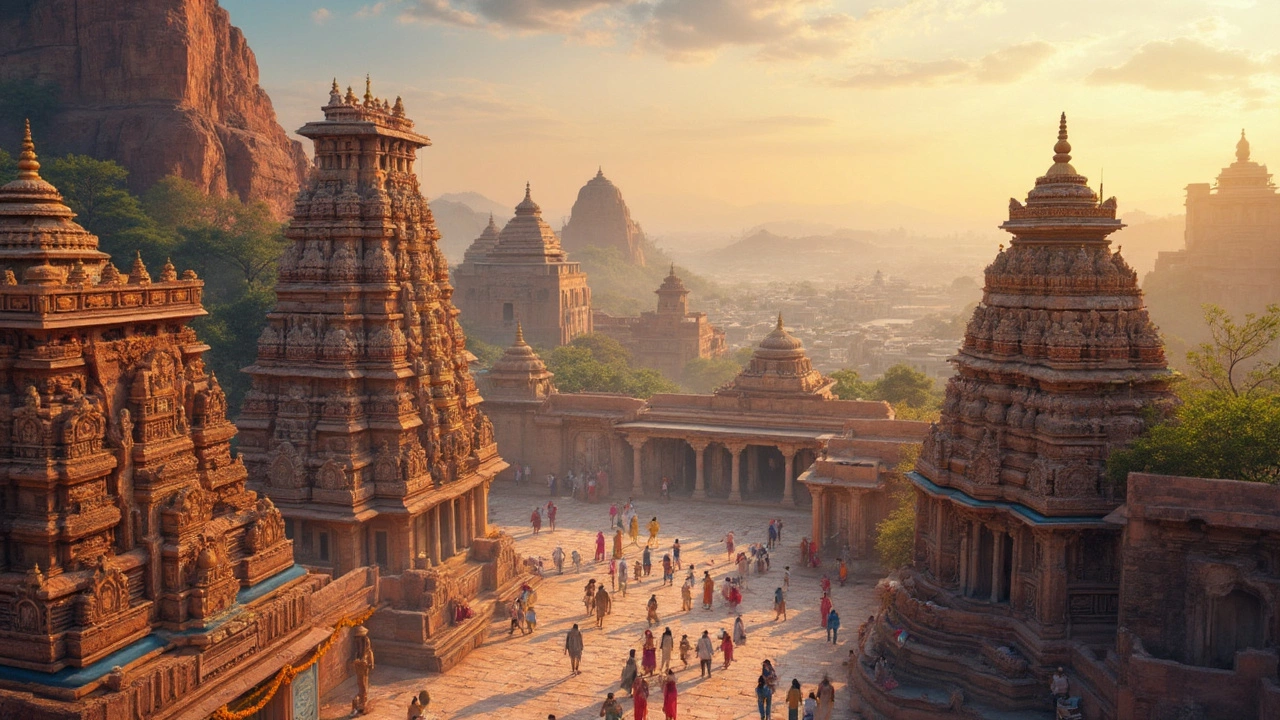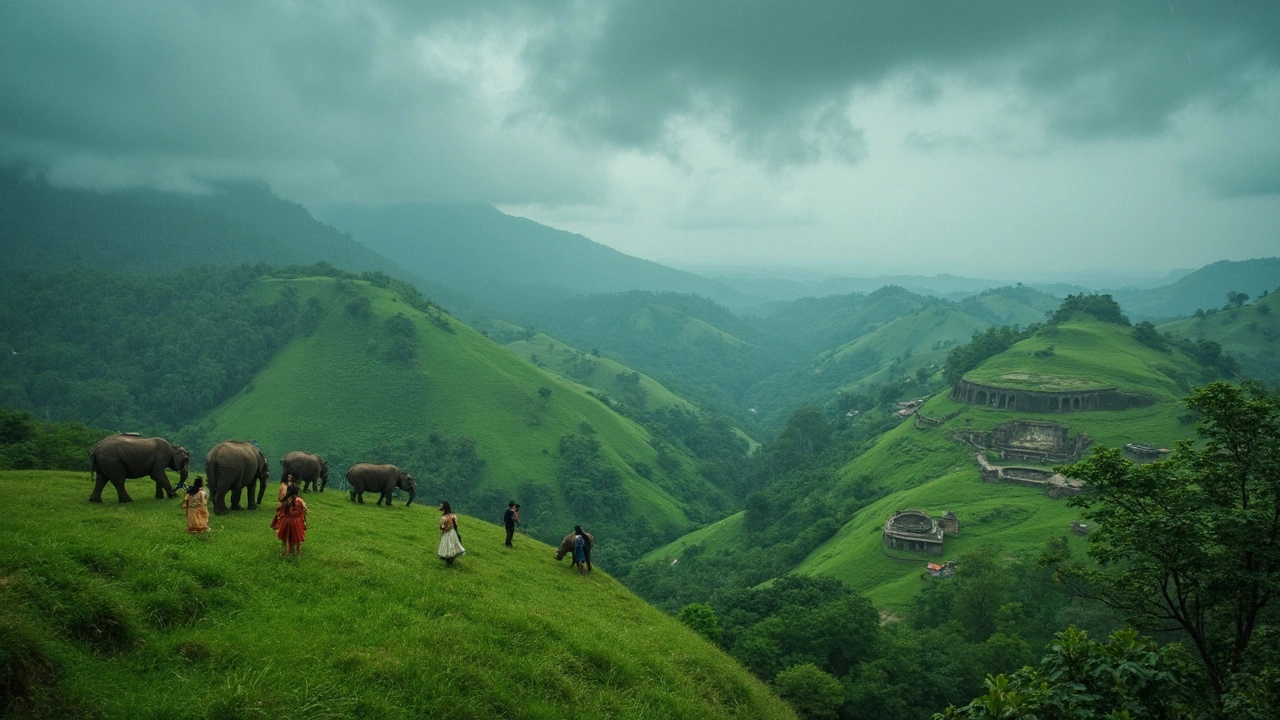India’s Heritage Sites: Exploring the World’s Richest Heritage
 May, 13 2025
May, 13 2025
Trying to settle the debate on which country owns the world’s richest heritage? India always lands at the top. If you look at the number of recognized heritage sites and the wild diversity they represent, it’s tough for any country to beat India. Here, centuries of history and culture collide in forts, palaces, ancient cave art, and cities that still feel alive with old-world charm.
Visiting India’s heritage sites isn’t just about ticking off a list—you’re walking into stories that have shaped entire civilizations. Ever wandered through streets older than Rome, or stood in a temple built before the birth of most European countries? That’s the everyday reality here. India’s sites aren’t relics to be looked at from a distance; they’re places where local life and tradition still pulse.
- Why India Leads in World Heritage
- Unmissable Heritage Sites: My Top Picks
- Stories Behind the Stones
- Tips for Experiencing Indian Heritage
Why India Leads in World Heritage
Ask anyone who’s traveled across India, and they’ll tell you—this country’s past is everywhere. India isn’t just part of the global heritage conversation; it’s sitting at the front. Officially, India has 42 UNESCO World Heritage Sites as of 2025, the sixth highest in the world. That number keeps growing because new places keep making the cut, from ancient cities to national parks.
So, why does India stand out? First off, the variety is wild. You’ve got rock-cut caves older than most countries, massive forts that whisper stories of old kings, and temples where people still bring offerings daily. It’s not just about the old stuff either—India blends natural wonders like Kaziranga National Park or the Western Ghats with historic architecture. The result? A mix you don’t really see anywhere else.
Here’s a quick rundown of what makes India unique in the world heritage game:
- Heritage that goes back over 5,000 years, like the Indus Valley sites.
- Influences from dozens of dynasties, cultures, and religions all layered together.
- Living heritage—most sites aren’t “dead” museums. They buzz with local life, festivals, and rituals.
- Natural UNESCO sites sitting side-by-side with temples and palaces.
Check out this snapshot of the numbers:
| Type | Number of Sites |
|---|---|
| Cultural | 34 |
| Natural | 7 |
| Mixed | 1 |
What really puts India in a league of its own is how everyday people still interact with these places. Some countries put ropes and glass around their old sites. But in India? Weddings happen in old forts, morning prayers echo through thousand-year-old temples, and you might spot school kids exploring caves with guides who know every legend. It’s this active, living connection that gives India’s heritage sites an edge you won’t find anywhere else.
Unmissable Heritage Sites: My Top Picks
You could spend years traveling in India and still not see every single heritage site. But if you want the highlights, these picks cover a huge mix—from old dynasties to modern movements. They show off what makes India heritage sites unique from anywhere else.
- Taj Mahal, Agra: Not just a fancy landmark for Instagram. Built in the 1600s by Emperor Shah Jahan for his wife Mumtaz Mahal, the Taj draws about 8 million visitors a year. It's all white marble, optical illusions, and symmetry—considered the best example of Mughal architecture.
- Qutub Minar, Delhi: This tower is almost 73 meters tall, and it’s the world’s tallest brick minaret built way back in the 12th century. Walk around the ruins of ancient Delhi here, and you’ll find stories of dynasties battling for power.
- Hampi, Karnataka: Once the capital of the Vijayanagara Empire, this site is like a lost city. You’ll see giant boulders, ruined temples, and market streets. In 2023, Hampi started hosting open-air music festivals, mixing old vibes with new culture.
- Ellora & Ajanta Caves, Maharashtra: These caves aren’t your average carvings. Some of them are 2,000 years old, cut by hand into cliffs—filled with Buddhist, Hindu, and Jain art. Ellora has the world’s largest monolithic rock excavation.
- Kaziranga National Park, Assam: Heritage in India isn’t just buildings—nature gets a spot too. Kaziranga protects over two-thirds of the world’s one-horned rhinos. It’s also the only site in the world where you might spot both wild tigers and elephants by the same riverbank.
- Group of Monuments at Khajuraho, Madhya Pradesh: Known for their wild, detailed sculptures. Khajuraho’s temples were built about 1,000 years ago and survived being hidden under jungle for centuries. Today, they’re famous for carvings that show daily life and ancient love stories.
These aren’t just tourist spots—they’re places where you can see India’s history shift right in front of you. Each of them pulls in both curious locals and travelers from all over.
| Site | Location | Year Recognized by UNESCO | Main Feature |
|---|---|---|---|
| Taj Mahal | Agra, Uttar Pradesh | 1983 | White marble, Mughal architecture |
| Qutub Minar | Delhi | 1993 | Historical minaret, Islamic art |
| Ellora Caves | Maharashtra | 1983 | Rock-cut Buddhist, Hindu, Jain monuments |
| Hampi | Karnataka | 1986 | Ruined city, Vijayanagara Empire |
| Kaziranga National Park | Assam | 1985 | Wildlife, rhinos, tigers |
Beat the crowds by visiting early mornings or late afternoons. Weekdays are way less hectic than weekends, especially at the Taj Mahal. Always check local festival dates—sites like Hampi and Khajuraho get a whole new energy during celebrations with music, dance, and local food everywhere.

Stories Behind the Stones
There’s a reason folks say you haven’t seen true history until you’ve walked through India’s heritage sites. Every spot is loaded with wild stories, jaw-dropping facts, and surprising connections to the modern world. Let’s break it down with details people usually miss.
The Taj Mahal is a global celebrity, but did you know it took around 22 years to finish? Over 20,000 workers and artisans from all over Asia helped build it, and legend says the emperor wanted to build a matching black marble Taj—he never got the chance. Then there’s the Ajanta and Ellora Caves in Maharashtra. These aren’t just old carvings; some cut straight into cliffs as far back as the 2nd century BCE. Monks actually lived and meditated here for years! If you’re curious about numbers, check this out:
| Site | Year Added (UNESCO) | Estimated Age | Key Fact |
|---|---|---|---|
| Taj Mahal | 1983 | 370 years | Symbol of love, perfect symmetry |
| Ajanta Caves | 1983 | Over 2,200 years | Oldest known Buddhist art |
| Qutb Minar | 1993 | 800 years | World’s tallest brick minaret |
| Konark Sun Temple | 1984 | 770 years | Chariot-shaped temple, wheels as sundials |
For anyone into ancient science, the Konark Sun Temple in Odisha isn’t just pretty to look at—the wheels carved on the side work as sun dials and still tell time. The Qutb Minar in Delhi has stood through earthquakes and invasions, standing 73 meters tall and built with red sandstone that changes color throughout the day.
There’s also the Great Living Chola Temples in Tamil Nadu. Constructed over 1,000 years ago, these temples still host festivals, and local families see them as part of daily life, not just museums. That connection between people and place? That’s what sets India apart.
If you want your visit to be more than a photo op, dig into the stories with a local guide or even strike up a chat with the caretakers. Ask about hidden carvings, ghost stories, or old rituals—there's always more happening than what's in the guidebook.
Tips for Experiencing Indian Heritage
If you want to see the real India, step out of the guidebook pages. Here’s how to get the most out of your visit to India heritage sites—from must-do experiences to small tricks that make a big difference.
- Start Early, Stay Late: Popular sites like the Taj Mahal or Qutub Minar get packed. Show up at sunrise to actually enjoy the space and snap photos before crowds roll in. If that’s not possible, try visiting an hour before closing when many tourists leave.
- Mix Well-Known and Hidden Gems: Yes, you want to see big names like Agra Fort. But don’t sleep on places like Hampi or the Sun Temple at Konark. Some of these get surprisingly few visitors and you’ll get a more personal feel of India’s rich past.
- Pack Smartly and Dress Right: India is hot in most months, especially around major heritage spots. Light cotton, a hat, and comfy walking shoes are lifesavers. Remember, temples and some old sites like Ajanta Caves require you to dress modestly—shoulders and knees covered.
- Hire a Local Guide: A good guide turns a bunch of stones into history that sticks. Look for those licensed by the Archaeological Survey of India or recommended by official tourism boards. Skip random touts at the entrances.
- Respect Local Customs: Tons of sites are living heritage—meaning they’re still in use for worship or community events. Don’t interrupt prayers, watch where you step, and always ask before taking photos, especially inside temples.
One more tip: keep cash handy. Many small ticket offices don’t accept cards, and rural areas don’t always have ATMs.
If you’re a foodie, local street food around heritage areas is part of the experience—think masala chai near the Taj or thalis in Jaipur. Just stick to crowded stalls and check that food is freshly made.
Lastly, pace yourself. You can’t “do” Indian heritage in one trip. Pick a region—like Rajasthan, Tamil Nadu, or Madhya Pradesh—spend time soaking it in, and you’ll get stories and little details you’ll never forget.